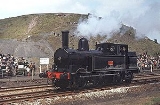
LNWR Webb Coal Tank
Encyclopedia
The London and North Western Railway
(LNWR) Webb Coal Tank is a class of 0-6-2T steam locomotive. They were called "Coal Tanks" because they were a side tank version of Webb's standard 17 in Coal Engine
, an 0-6-0
tender engine for slow freight trains.
The design was introduced in 1881 by F.W. Webb
and had the same cheaply produced cast iron wheels and H-section spokes as the tender engines. A trailing radial truck supporting the bunker
was added also with two similarly cast iron wheels. Three hundred were built between 1881 and 1897.
Four (LNWR nos. 178, 484, 1257, 69) were withdrawn in January–February 1920 and a further four (LNWR nos. 142, 994, 782, 1012) in July and November 1922, so at the 1923 grouping
, 292 passed to the London Midland and Scottish Railway (LMS). They were renumbered from the LNWR's random allocation based on vacant numbers, to a solid block sequence 7550–7841, and given the power classification 1F. Many locomotives still in service in 1934 were renumbered by the addition of 20,000 to their number.
Sixty-four locomotives passed into British Railways ownership in 1948 and they were numbered 58880–58937, but not all survived long enough to carry their BR numbers.
, carrying its LNWR livery and number.
London and North Western Railway
The London and North Western Railway was a British railway company between 1846 and 1922. It was created by the merger of three companies – the Grand Junction Railway, the London and Birmingham Railway and the Manchester and Birmingham Railway...
(LNWR) Webb Coal Tank is a class of 0-6-2T steam locomotive. They were called "Coal Tanks" because they were a side tank version of Webb's standard 17 in Coal Engine
LNWR 17in Coal Engine
The LNWR 17in Coal Engine was a class of 0-6-0 steam tender engines designed by Francis Webb for the London and North Western Railway. They were simple locomotives and in UK service they were very reliable. "17in" refers to their cylinder diameter in inches...
, an 0-6-0
0-6-0
Under the Whyte notation for the classification of steam locomotives, 0-6-0 represents the wheel arrangement of no leading wheels, six powered and coupled driving wheels on three axles, and no trailing wheels...
tender engine for slow freight trains.
The design was introduced in 1881 by F.W. Webb
Francis Webb (engineer)
Francis William Webb was a British engineer responsible for the design and manufacture of locomotives for the London and North Western Railway .- Biography :...
and had the same cheaply produced cast iron wheels and H-section spokes as the tender engines. A trailing radial truck supporting the bunker
Bunker
A military bunker is a hardened shelter, often buried partly or fully underground, designed to protect the inhabitants from falling bombs or other attacks...
was added also with two similarly cast iron wheels. Three hundred were built between 1881 and 1897.
Four (LNWR nos. 178, 484, 1257, 69) were withdrawn in January–February 1920 and a further four (LNWR nos. 142, 994, 782, 1012) in July and November 1922, so at the 1923 grouping
Railways Act 1921
The Railways Act 1921, also known as the Grouping Act, was an enactment by the British government of David Lloyd George intended to stem the losses being made by many of the country's 120 railway companies, move the railways away from internal competition, and to retain some of the benefits which...
, 292 passed to the London Midland and Scottish Railway (LMS). They were renumbered from the LNWR's random allocation based on vacant numbers, to a solid block sequence 7550–7841, and given the power classification 1F. Many locomotives still in service in 1934 were renumbered by the addition of 20,000 to their number.
Sixty-four locomotives passed into British Railways ownership in 1948 and they were numbered 58880–58937, but not all survived long enough to carry their BR numbers.
Preservation
One BR 58926, ex-LMS 7799, neé LNWR 1054, has survived to preservation on the Keighley and Worth Valley RailwayKeighley and Worth Valley Railway
The Keighley and Worth Valley Railway is a long branch line that served mills and villages in the Worth Valley and is now a heritage railway line in West Yorkshire, England. It runs from Keighley to Oxenhope. It connects to the national rail network line at Keighley railway station...
, carrying its LNWR livery and number.

